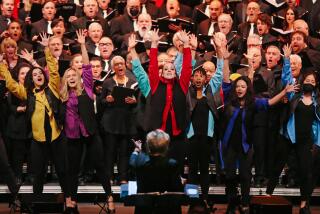MUSIC REVIEW : Tantric University Choir Chants at CalArts
- Share via
Twenty-one Tibetan monks may seem unlikely candidates to become a trendy vocal group. The siren lure of the Gyuto Tantric University Choir, however, filled the Main Gallery at CalArts on Monday evening with intrepid, mostly attentive, cultural adventurers, and another local gig beckons tonight at UCLA’s Royce Hall.
The current popularity of the group seems due in part to its reputed influence on members of the Grateful Dead and curiosity about its specialized vocal technique. Advance reports claimed that each member of the choir could sing three-pitch chords and possessed a range of six octaves.
Perhaps in some metaphysical sense that is true. Musically, however, it is a question of overtones and their interpretation. The highly amplified monks--headsets with microphones proved an incongruous part of their elaborate vestments--intone a very low, overtone-rich fundamental, apparently on inhalation rather than exhalation.
If that can be considered a chord, then the monks’ cymbals, also generating audible harmonic partials, produce chords as well, as do many other single-sound sources.
On the question of range, the overtone series technically extends out of the range of hearing. Practically, the chants centered on a single reciting tone, with microtonal inflections above and below, plus rare, brief and equally limited forays into normal baritone range.
The first portion of the program consisted of liturgical chants from the Buddhist “Glorious Diamond Terrific Yamantaka.” Led by a solo cantor in responsorial fashion, the monks dwelt heavily on the same tones and syllables in each chant, in a slow, steady rhythm, embellished with small hand bells.
The effect was a rumbling evocation, earthy and timeless--as indeed it must have seemed to those outside the circle of belief after the opening chant ran a solid 30 minutes.
Variety was achieved most overtly in visual cues--changes in position and costume--and in instrumentation. The chants of the second half were supported with long brass trumpets, shawms, pole drums and cymbals, in a comparative musical riot. The metrical pulse, though, remained constant, as did the type of chanting and its pitch center.
More to Read
The biggest entertainment stories
Get our big stories about Hollywood, film, television, music, arts, culture and more right in your inbox as soon as they publish.
You may occasionally receive promotional content from the Los Angeles Times.










